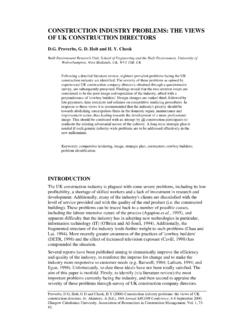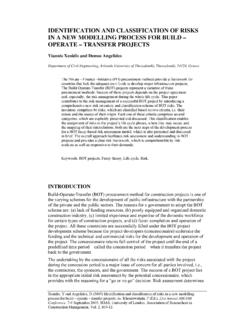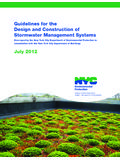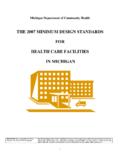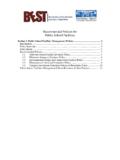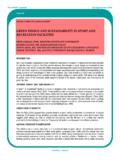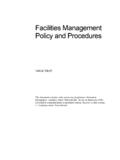Transcription of THE ROLE OF FACILITIES MANAGEMENT AT THE DESIGN …
1 THE ROLE OF FACILITIES MANAGEMENT AT THE. DESIGN STAGE. Aghahowa Enoma1. School of the built environment, Heriot-Watt University, Edinburgh, UK. FACILITIES MANAGEMENT is a new discipline, an exciting profession that embraces many essential areas of the built environment. The last two decades have witnessed a significant growth in the profession to the extent that there is the need to be clear on its roles both in the industry and organisation. This study looks at the role of FACILITIES MANAGEMENT in the procurement of a facility. It tries to highlight the advantages of the early involvement of the FACILITIES manager in the procurement process. The methodology for this study is through interviews of professionals in construction and service providers as well as FACILITIES managers and designers.
2 Emphasis is placed on the attainment of value for money, Customer satisfaction and the delivery of a better building; that is economic to run, easy for the occupiers to maintain, control and manage, better able to respond to the needs of the occupants .In promoting the role of FACILITIES managers, their influence and contributions to the DESIGN process, the FACILITIES manager ensures the effective MANAGEMENT of the supply chain. By promoting team work and collaboration through the DESIGN process, FACILITIES MANAGEMENT also encourages dialogue by indicating the benefits of partnership amongst the project team members. And while the project team takes decisions that will meet the business need of the facility over its useful life, they also make provisions for the future maintenance of the facility.
3 The FACILITIES manager's concern at the DESIGN stage will be the delivery of an efficient facility that is cost effective, and will respond to their subsequent roles in the facility on a day to day basis. Cost effective DESIGN solutions are then generated to meet the needs of the building objectives. Keywords: client, procurement process, project team, FACILITIES MANAGEMENT , value for money INTRODUCTION. A holistic view of the subject FACILITIES MANAGEMENT (FM) will involve looking at it from the definition and history of the development of FACILITIES MANAGEMENT , through the practice of FACILITIES MANAGEMENT . It touches on some very important areas of the subject in relation to customer satisfaction and providing good value for money.
4 It looks at achieving better facility that is easy to run, maintain and manage by applying whole life costing and risk MANAGEMENT techniques. The use of value MANAGEMENT as a means of meeting client perceived needs. The use of technology, communication and their influence in today's business is examined. FM is examined at the pre- operations stage to see how early involvement can create effective operations, greater value for money and customer satisfaction while also providing better facility that is attractive and user friendly. FM at the DESIGN stage will add value to the facility by ensuring less rework', emphasising value for money, efficient control of the supply chain and team work'. 1. Enoma, A (2005) The role of FACILITIES MANAGEMENT at the DESIGN stage.
5 In: Khosrowshahi, F (Ed.), 21st Annual ARCOM Conference, 7-9 September 2005, SOAS, University of London. Association of Researchers in construction MANAGEMENT , Vol. 1, 421-30. Enoma DEFINITION AND DEVELOPMENTS IN THE PROFESSION OF. FACILITIES MANAGEMENT . The British institute of FACILITIES MANAGEMENT (BIFM) defines FACILITIES MANAGEMENT as the practice of coordinating the physical workplace with people and work of an organisation. Bernard Williams Associates (1999) looks at FACILITIES MANAGEMENT as a MANAGEMENT process, which includes analytical and systematic approaches used to determine and deliver the agreed levels of service activities that are required to manage, operate, maintain and support a facility in a quality environment at appropriate cost to meet the business requirements.
6 Hendrickson and Au (1988) see it as the discipline of planning, designing, constructing and managing space, in every type of structure, from office building to process plant. Becker (1990) presents a picture of FM as a subset of general MANAGEMENT . FM is responsible for coordinating all efforts relating to planning, designing, and managing buildings and their systems, equipments and furniture to enhance the organisation's ability to compete successfully in a rapidly changing world. All the above definitions have MANAGEMENT , workplace, people, MANAGEMENT process in common, it is clear that FM is an umbrella term which brings together a wide range of issues for the benefits of the organisation in achieving efficiency and effectiveness at an optimal combination of cost, quality and time.
7 The hard issues are building, equipment, furniture and the soft being people, process, safety environment, they are all the responsibilities of FACILITIES MANAGEMENT . To obtain maximum benefit from a constructed facility, some owners and developers would add strategic planning at the beginning and facility maintenance as a follow up in the project lifecycle. Alexander(1994), Then (1999) and others after them took the definition further by looking at FACILITIES MANAGEMENT as a belief in the potentials to improve processes by which workplaces can be managed to inspire people to give their best, to support their effectiveness and ultimately to make a positive contribution to economic growth and organisational success.
8 A situation, which creates for, learned debate, for sharing and validating experience. They also advices that the future of FACILITIES MANAGEMENT be built on a strong programme of education and research dedicated to understanding and developing the discipline, to a collective knowledge base and to identifying and codifying best practice. Atkin and Brooks (2002) defined FACILITIES MANAGEMENT as an integrated approach to operating, maintaining, improving and adapting the building infrastructure of an organisation in order to create an environment that strongly supports the primary objective of that organisation. In practice, by creating an environment that is conducive to carrying out the organisation's primary operations, taking an integrated view of the service infrastructure, and using this to deliver customer satisfaction and value for money through support for and enhancement of the core business, you are practicing FACILITIES MANAGEMENT .
9 To understand FACILITIES MANAGEMENT there is the need to examine the interface with built environment, DESIGN and construction . Understanding where FACILITIES MANAGEMENT impacts on the DESIGN and construction process; how FACILITIES MANAGEMENT creates value added to the facility by users and occupants of the constructed FACILITIES , how the use of FACILITIES MANAGEMENT during the DESIGN construction process can lead to gains, saving in cost and time and less failure in constructed FACILITIES , the impact or the role of FACILITIES MANAGEMENT in the success of the built environment. 422. The Role of FACILITIES MANAGEMENT at the DESIGN stage RELATIONS WITH BUILT ENVIRONMENT. Bosch and Pearce (2003) capitalized on the evidence that sustainable DESIGN and construction contributes to the creation of FACILITIES that are energy efficient, cost less over their life cycle and improves worker productivity.
10 In their review of nine guidance documents deemed to educate FACILITIES decision makers, while offering a framework for a sustainable DESIGN process. They reported that the active participation of FACILITIES managers during the planning, DESIGN , and construction phases ensure that sustainable strategies are not undermined after the FACILITIES are delivered, and that future plans and policies for the facility is kept. Okoroh et al. (2003) provides insights into derivation of values by users of the built environment through FACILITIES MANAGEMENT . They observed that a close link between life cycle planning and DESIGN , construction and FACILITIES maintenance contributes to the derivation of value by stakeholders in hotels.



